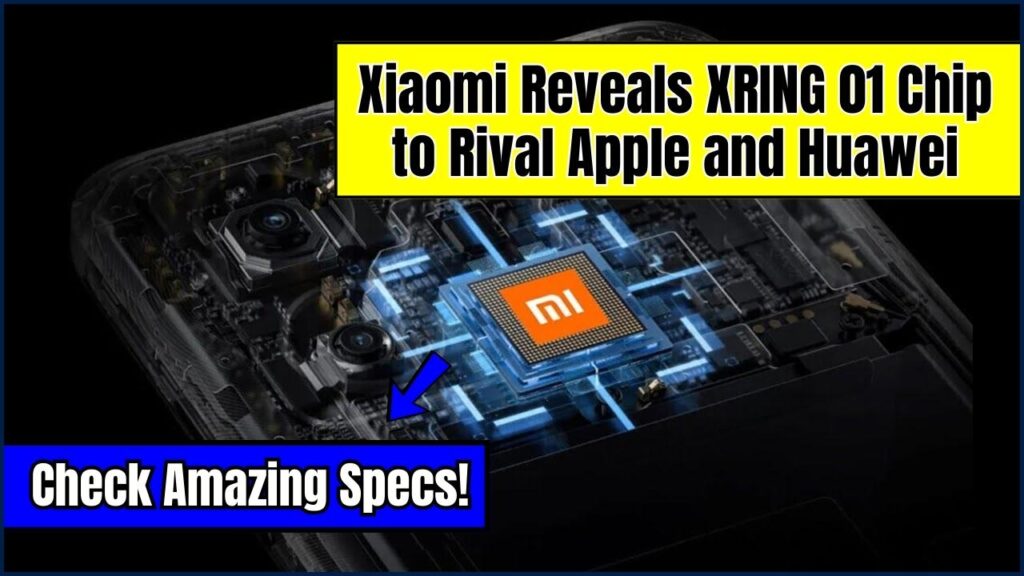Xiaomi Reveals XRING 01 Chip: Xiaomi has just flipped the smartphone game. The Chinese tech giant has officially revealed its first-ever self-developed mobile chip, the XRING 01, a silicon powerhouse designed to compete directly with Apple’s A17 Pro and Huawei’s Kirin 9000S.
This ain’t your average chip drop—it’s a major shift in how Xiaomi sees its future: independent, powerful, and ready to control its entire tech ecosystem, just like Apple.

Xiaomi Reveals XRING 01 Chip
| Feature | Details |
|---|---|
| Chip Name | XRING 01 |
| Developer | Xiaomi (In-house) |
| CPU | Octa-core (1x Cortex-X925, 3x A725, 4x A520) |
| GPU | IMG DXT72 @ 1.3GHz |
| Performance Claim | Beats Snapdragon 8 Gen 2’s Adreno 740 |
| Fabrication Process | TSMC 4nm N4P |
| Expected First Device | Xiaomi 15s (unconfirmed) |
| Launch Timeline | Late May 2025 |
| Strategic Goal | Reduce Qualcomm/MediaTek dependency; go full-stack like Apple |
| Official Link | Xiaomi Global Announcement |
With the launch of the XRING 01 chip, Xiaomi is no longer just another phone maker—it’s now a chipmaker, a platform creator, and a serious player in global tech.
If XRING 01 lives up to its promises, it could bring faster phones, better graphics, and longer battery life to Xiaomi’s devices. But more than that—it proves Xiaomi is ready to go head-to-head with Apple, Huawei, and even Google in building the future of smart devices.
Why XRING 01 Matters More Than You Think
The Xiaomi XRING 01 is not just a chip—it’s a declaration of independence. After a decade of relying on third-party chips, Xiaomi now joins elite club members like Apple (A-Series) and Huawei (Kirin) with its own custom-designed brain.
This shift allows Xiaomi to:
- Tightly integrate hardware and software for smoother performance.
- Optimize energy use for longer battery life.
- Build a connected device ecosystem, from smartphones to electric vehicles (EVs).
Under the Hood: What’s in the XRING 01 Chip?
CPU Powerhouse
- 1x Cortex-X925 @ 3.2GHz: The speed demon—handles heavy gaming and app loads.
- 3x Cortex-A725 @ 2.6GHz: Mid-power performance cores for multi-tasking.
- 4x Cortex-A520 @ 2.0GHz: Lightweight power-sippers for background processes.
Graphics Like You’ve Never Seen
- IMG DXT72 GPU @ 1.3GHz: Beats Adreno 740, seen in Snapdragon 8 Gen 2.
- Built for smooth gaming, video rendering, and AR/VR applications.
4nm Fab Process
- Made by TSMC on its latest 4nm N4P node.
- Smaller transistors = better performance, cooler chips, and longer battery life.
How It Compares: XRING 01 vs Top Chips
| Feature | XRING 01 (Xiaomi) | A17 Pro (Apple) | Snapdragon 8 Gen 2 |
|---|---|---|---|
| Core Count | 8 cores | 6 cores | 8 cores |
| Top Speed | 3.2GHz | 3.78GHz | 3.2GHz |
| GPU | IMG DXT72 | Apple 6-core GPU | Adreno 740 |
| AI Capabilities | Under development | Neural Engine (35 TOPS) | Hexagon DSP |
| Process Node | TSMC 4nm N4P | TSMC 3nm | TSMC 4nm |
| Performance Lead | GPU > Snapdragon 8 Gen 2 | CPU > all competitors | Strong CPU, weaker GPU |
Xiaomi’s Journey to the XRING 01
This isn’t Xiaomi’s first chip rodeo. Back in 2017, it launched the Surge S1—but that project fizzled. The XRING 01 shows how far Xiaomi has come.
What changed?
- Increased R&D spending (over $2 billion/year).
- Expanded semiconductor design teams across Beijing and Shanghai.
- Stronger partnerships with TSMC and Imagination Technologies.
What Experts Are Saying
“Xiaomi is doing what only a few tech firms in the world have dared—taking full control of its hardware stack. XRING 01 is a strong statement,”
says Ben Wood, Chief Analyst at CCS Insight.
“The GPU performance benchmark puts it ahead of Qualcomm’s current flagship—this could disrupt the Android chip hierarchy,”
notes Shenzhen-based analyst Mei Ling.
How This Impacts the Global Chip Market
With U.S.–China tensions around semiconductors heating up, Xiaomi’s chip launch is a big deal:
- Reduces dependency on U.S.-linked tech like Qualcomm.
- Aligns with China’s “Made in China 2025” semiconductor strategy.
- Signals future competition for Samsung, Apple, and Google in silicon.
What’s Next: XRING 02 and Beyond?
While XRING 01 is built for smartphones, Xiaomi may already be thinking bigger:
- A lite version for IoT products?
- A high-performance version for tablets or foldables?
- A dedicated AI chip for camera and voice processing?
Buyer Tips: Should You Wait for an XRING Phone?
Here’s what to consider before you buy Xiaomi’s first XRING phone:
- Wait for real-world reviews—benchmarks aren’t everything.
- Check MIUI optimization—will it feel smoother than Snapdragon phones?
- Battery life could be a game changer, thanks to Xiaomi’s software-hardware tuning.
Frequently Asked Questions About Xiaomi Reveals XRING 01 Chip
Q1. What is XRING 01?
Xiaomi’s first-ever self-developed mobile chip designed to power premium smartphones and compete with Apple, Qualcomm, and Huawei.
Q2. Is XRING 01 better than Snapdragon 8 Gen 2?
In GPU benchmarks, yes. But real-world usage will depend on software integration and thermal performance.
Q3. When is it launching?
Xiaomi plans to debut XRING 01 in late May 2025, likely inside a Xiaomi 15 series refresh.
Q4. Will XRING chips come to smart home or EVs?
Possibly. Xiaomi has hinted at broader applications for its in-house silicon.
Q5. How long has Xiaomi worked on this?
Over 10 years. It started with the Surge chip line, and now XRING marks its full-scale return.











